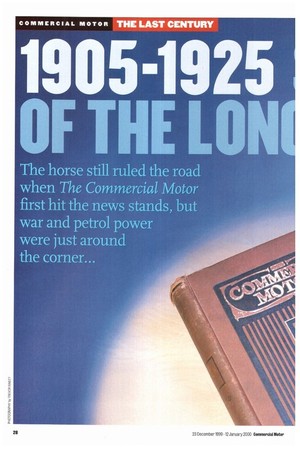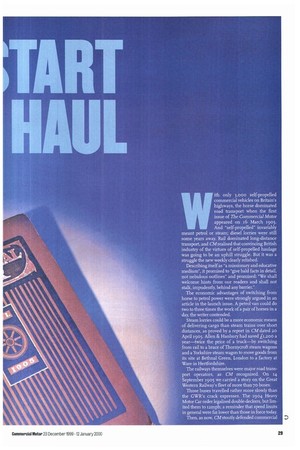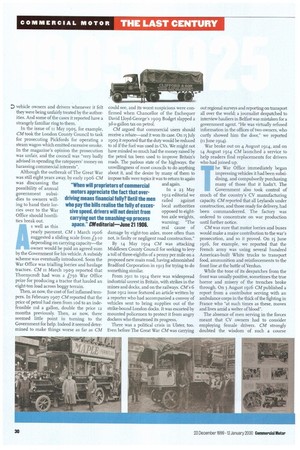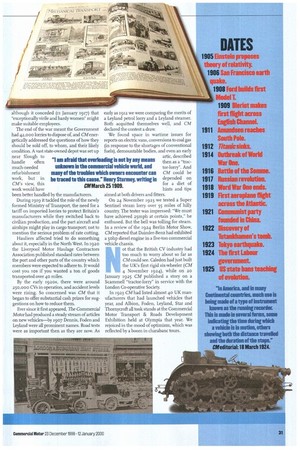1905 1925 OF TfELON
Page 30

Page 31

Page 32

Page 33

If you've noticed an error in this article please click here to report it so we can fix it.
The horse still ruled the road when The Commercial Motor first hit the news stands, but war and petrol power were just around the corner...
ith only 3,000 self-propelled commercial vehicles on Britain's highways, the horse dominated road transport when the first issue of The Commercial Motor appeared on 16 March 1905. And "self-propelled" invariably meant petrol or steam; diesel lorries were still some years away. Rail dominated long-distance transport, and CM realised that convincing British industry of the virtues of self-propelled haulage was going to be an uphill struggle. But it was a struggle the new weekly clearly relished.
Describing itself as "a missionary and educative medium", it promised to "give bald facts in detail, not nebulous outlines" and promised: "We shall welcome hints from our readers and shall not stalk, impudently, behind any barrier."
The economic advantages of switching from horse to petrol power were strongly argued in an article in the launch issue. A petrol van could do two to three times the work of a pair of horses in a day, the writer contended.
Steam lorries could be a more economic means of delivering cargo than steam trains over short distances, as proved by a report in CM dated zo April 1905. Allen & Hanbury had saved 11,200 a year—twice the price of a truck—by switching from rail to a brace of Thornycroft steam wagons and a Yorkshire steam wagon to move goods from its site at Bethnal Green, London to a factory at Ware in Hertfordshire.
The railways themselves were major road transport operators, as CM recognised. On 14 September 1905 we carried a story on the Great Western Railway's fleet of more than 70 buses. Those buses travelled rather more slowly than the GWR's crack expresses. The 1904 Heavy Motor Car order legalised double-deckers, but limited them to rzmph; a reminder that speed limits in general were far lower than those in force today. Then, as now, CM stoutly defended commercial D vehicle owners and drivers whenever it felt they were being unfairly treated by the authorities. And some of the cases it reported have a strangely familiar ring to them.
In the issue of II May 1905, for example. CM took the London County Council to task for prosecuting Pickfords for operating a steam wagon which emitted excessive smoke. In the magazine's opinion the prosecution was unfair, and the council was "very badly advised in spending the ratepayers' money on harassing commercial interests".
Although the outbreak of The Great War was still eight years away, by early 1906 CM
was discussing the "When will proprietors of commercial possibility of annubsal
government
As well as this yearly payment, CM 1 March 1906 suggested a sliding scale from 13-io depending on carrying capacity—the owner would be paid an agreed sum by the Government for his vehicle. A subsidy scheme was eventually introduced. Soon the War Office was trialling lorries and haulage tractors. CM II March 1909 reported that Thornycroft had won a 1750 War Office prize for producing a tractor that hauled an eight-ton load across boggy terrain.
Then, as now, the cost of fuel inflamed tempers. In February 1907 CM reported that the price of petrol had risen from Lod to an indefensible rid a gallon, double the price 12 months previously. Then, as now, there seemed little point in turning to the Government for help. Indeed it seemed determined to make things worse as far as CM motors appreciate the fact that over
could see, and its worst suspicions were confirmed when Chancellor of the Exchequer David Lloyd-George's 1909 Budget slapped a 3d-a-gallon tax on petrol.
CM argued that commercial users should receive a rebate—and it won its case. On 15 July 19o9 it reported that the duty would be reduced to id if the fuel was used in CVs. We might not have minded so much had the money raised by the petrol tax been used to improve Britain's roads. The parlous state of the highways, the unwillingness of most councils to do anything about it, and the desire by many of them to impose tolls were topics it was to return to again and again.
In a 23 May 1912 editorial we railed against local authorities opposed to eightton axle weights, warning: "The real cause of damage by eight-ton axles, more often than not, is faulty or negligent road construction."
By 14 May 1914 CM was attacking Middlesex County Council for seeking to levy a toll of three-eighths of a penny per mile on a proposed new main road, having admonished Bradford Corporation in 1913 for trying to do something similar.
From 1911 to 1914 there was widespread industrial unrest in Britain, with strikes in the mines and docks, and on the railways. CM'S 6 June 1912 issue featured an article written by a reporter who had accompanied a convoy of vehicles sent to bring supplies out of the strike-bound London docks. It was escorted by mounted policemen to protect it from angry dockers who threatened its progress.
There was a political crisis in Ulster, too. Even before The Great War CM was carrying
sive speed, drivers will not desist from carrying out the smashing-up process apace." CMeditorial—June 21 1906.
out regional surveys and reporting on transport all over the world; a journalist despatched to interview hauliers in Belfast was mistaken for a government agent. "He was virtually refused information in the offices of two owners, who curtly showed him the door," we reported (ii June 1914).
War broke out on 4 August 1914, and on 14 August 1914 CM launched a service to help readers find replacements for drivers who had joined up.
The War Office immediately began impressing vehicles it had been subsidising, and compulsorily purchasing many of those that it hadn't. The Government also took control of much of the country's CV manufacturing capacity. CM reported that all LeylancLs under construction, and those ready for delivery, had been commandeered. The factory was ordered to concentrate on war production until further notice.
CM was sure that motor lorries and buses would make a major contribution to the war's prosecution, and so it proved. On 15 June 1916, for example, we reported that the French army was using several hundred American-built White trucks to transport food, ammunition and reinforcements to the front line at the battle of Verdun.
While the tone of its despatches from the front was usually positive, sometimes the true horror and misery of the trenches broke through. On 3 August 1916 CM published a report from a contributor serving with an ambulance corps in the thick of the fighting in France who "at such times as these, moves and lives amid a welter of blood".
The absence of men serving in the forces meant that CV owners had to consider employing female drivers. CM strongly doubted the wisdom of such a course
although it conceded (ii January 1917) that "exceptionally virile and hardy women" might make suitable employees.
The end of the war meant the Government had 42,000 lorries to dispose of and CMenergetically addressed the questions of how they should be sold off to whom, and their likely condition. A vast state-owned depot was set up near Slough to handle often much-needed refurbishment work, but in CM'S view, this work would have been better handled by the manufacturers.
During 1919 it tadded the role of the newly formed Ministry of Transport, the need for a tariff on imported lorries to protect Britain's manufacturers while they switched back to civilian production, and the part aircraft and airships might play in cargo transport; not to mention the serious problem of rate cutting.
Hauliers affected tried to do something about it, especially in the North West. In 1920 the Liverpool Motor Haulage Contractors Association published standard rates between the port and other parts of the country which members were expected to adhere to. It would cost you I OS if you wanted a ton of goods transported over 40 miles.
By the early 19205, there were around 250,000 CVs in operation, and accident levels were rising. So concerned was CM that it began to offer substantial cash prizes for suggestions on how to reduce them.
Ever since it first appeared, The Commercial Motor had produced a steady stream of articles on new vehicles—by 1907 Dennis, Foclen and Leyland were all prominent names. Road tests were as important then as they are now. As early as 1912 we were comparing the merits of a Leyland petrol lorry and a Leyland steamer. Both acquitted themselves well, and CM declared the contest a draw.
We found space in wartime issues for reports on electric vans, conversions to coal gas (in response to the shortages of conventional fuels), demountable bodies, and even an early artic, described then as a "tractor-lorry". And CM could be depended on for a diet of hints and tips aimed at both drivers and fitters.
On 24 November 1923 we tested a Super Sentinel steam lorry over 55 miles of hilly country. The tester was impressed: We must have achieved 25mph at certain points," he enthused. But the bell was tolling for steam. In a review of the 1924 Berlin Motor Show, CM reported that Daimler-Benz had exhibited a 5ohp diesel engine in a five-ton commercial vehicle chassis.
Not that the British CV industry had too much to worry about so far as CM could see. Caledon had just built the UK's first rigid six-wheeler (CM 4 November 1924), while on 20 January 1925 CM published a story on a Scammell "tractor-lorry" in service with the London Co-operative Society.
In /923 CM had listed almost 40 UK manufacturers that had launched vehicles that year, and Albion, Foden, Leyland, Star and Thomycroft all took stands at the Commercial Motor Transport & Roads Development Exhibition held at Olympia that year. We rejoiced in the mood of optimism, which was reflected by a boom in charabanc tours.
DATES
1905 Einstein proposes theory of relativity.
1906 San Francisco earth quake.
1908 Ford builds first Model T.
1909 Illeriot makes
first flight across English Channel.
1911 Amundsen reaches South Pole.
1912 Titalicsinks.
1914 Outbreak of World War One.
1916 Batde of the Somme. 1917 Russian revolution. 1918 Word War One ends. 1919 First aeroplane flight across the Atlantic. 1921 Communist party fomuled in China. 1922 Discovery of Tutaddiamen's tomb. 1923 Tokyo earthquake. 1924 The first lab=
government
1925 US state bans teaching of evolution.
In America and bi many Continental countries, much use is being made of a type of instrument known as the niming recorder. This is made in several forms, same indicating the time dwingwhich a veld* is in motion, others showing both the distance traveled and the duration of the stops." eMeditorial: 18 March 1924.




















































































































































